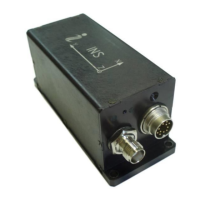INS
GUI User’s Manual
Inertial Labs, Inc
TM
Address: 39959 Catoctin Ridge Street, Paeonian Springs, VA 20129 U.S.A.
Tel: +1 (703) 880-4222, Fax: +1 (703) 935-8377 Website: www.inertiallabs.com
109
10.4. Calibration of the INS
For correct operation of the INS it is necessary that the calibrated sensors
are not distorted by external influences. It is particularly important to provide
non-distortion of the INS magnetic channel, as, due to the presence of the
carrier’s hard and soft iron in the vicinity to the INS, its magnetometers will
be outputting inaccurate data on the actual Earth magnetic intensity vector,
and, accordingly, inaccurate carrier’s heading angle value.
The Inertial Labs INS software allows compensation of influence of the
carrier object soft and hard iron on the heading angle calculation accuracy.
For this purpose, field calibration of the INS magnetometers is provided.
This calibration does not require any additional equipment, but it requires
turns of the carries object on which the INS is mounted.
Note INS does not require calibration of its magnetometers on
hard/soft iron if “Use_mags” switch is disabled in the “Settings” tab of
“Correction options…” window Fig. 4.24.
The INS can be calibrated using 2D, 3D, VG3D or 2D-2T calibration
procedure. Also on-the-fly VG3D calibration is provided (see section 10.4.4).
2D calibration is designed for carrier objects that move with small pitch and
roll angles (not more than a few degrees). The calibration procedure
involves a few full 360 rotations in the horizon plane of the carrier object
with the installed INS (see Fig. 10.4). During this calibration pitch and roll
angles must be as close to zero as possible.
3D calibration is designed for carrier objects that can operate with large
pitch and roll angles. For this calibration the carrier object is rotated in the
horizon plane (the Z-axis is up) with periodical stops about each 90 degrees
for tilting in pitch and roll (see Fig. 10.4 – Fig. 10.6). After full 360 rotation
the object with the INS is turned over (the Z-axis is down) and the procedure
described above should be repeated. During this calibration the range of
pitch and roll angles changing must be as much as possible.

